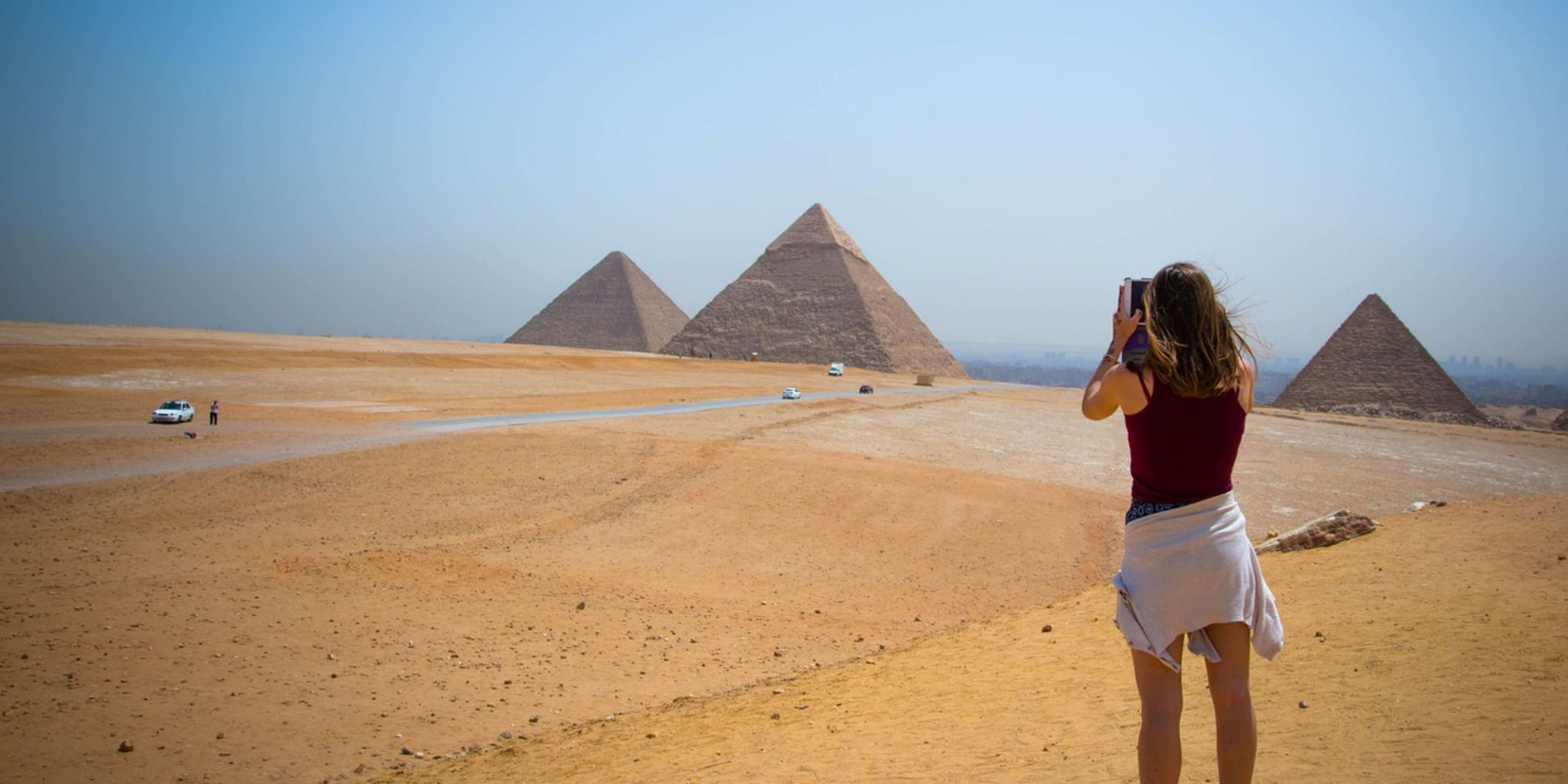Ancient Secret
This ancient diary reveals how Egyptians built the Great Pyramid The Pyramids of Giza are an architectural feat, and long thought a mystery. But the Red Sea Scrolls give an unprecedented look at who built the ancient wonder.

Located on the Egyptian coast of the Red Sea, Wadi al-Jarf is a quiet, unassuming place today. Dry desert sands and placid blue water stretch out as far as the eye can see; across the water one can spy the Sinai Peninsula. This seeming tranquility masks the busy hub it once was more than 4,000 years ago. Wadi al-Jarf’s historical importance was cemented in 2013 when 30 papyri, the world’s oldest, were found hidden away in manmade limestone caves there.
Aside from their age, the so-called Red Sea Scrolls are remarkable for their contents. Not only do they reveal Wadial-Jarf’s distant past as a bustling port, they also contain eyewitness accounts of a man named Merer who took part in the building of the Great Pyramid of Pharaoh Khufu.
The Wadi al-Jarf site was first discovered in 1823 by an English traveler and antiquarian, John Gardner Wilkinson, who believed its ruins to be a Greco-Roman necropolis. Then, in the 1950s, two archaeology-loving French pilots, François Bissey and René Chabot-Morisseau, stumbled upon the site again. They suggested that it had once been a center for metal production. But the 1956 Suez crisis delayed further investigation./https://tf-cmsv2-smithsonianmag-media.s3.amazonaws.com/filer/c2/d7/c2d7a9d8-e10e-463d-b801-695257bd1092/e8qsu-ywyacpe75.jpeg)
It wasn’t until 2008 that work at the site resumed. French Egyptologist Pierre Tallet led a series of excavations that definitively identified Wadi al-Jarf as an important port that dated back some 4,500 years to the reign of Khufu and the building of the Great Pyramid. Tallet’s teams revealed that Wadi al-Jarf was a vibrant economic hub at the center of the trade in materials used to build the pyramids, some 150 miles away. Supporting the archaeology was the landmark find of Merer’s diary among the papyri.
Pyramid port
The Wadi al-Jarf site consists of several different areas, spread over several miles between the Nile and the Red Sea. From the direction of the Nile, the first area, about three miles from the coast, contains some 30 large limestone chambers used for storage. It was in these caves that the papyri were discovered.
Continuing east toward the sea for another 500 yards, a series of camps appears, and after those, a large stone building divided into 13 parallel sections. Archaeologists surmised that the building was used as a residence. Finally, on the coast is the harbor itself with dwellings and more storage spaces. Using pottery and inscriptions found at the site, archaeologists have been able to date the harbor complex to Egypt’s 4th dynasty, some 4,500 years ago. They believe the harbor was inaugurated in the time of Pharaoh Sneferu and abandoned around the end of his son Khufu’s reign. It was active for a short period, but during that time the port was devoted to building Khufu’s tomb, known then as Akhet-Khufu,meaning “Horizon of Khufu.”
Along with the papyri, many other important archaeological finds there have revealed the importance of the port. Large structures, like the 600-foot-long stone jetty, show deep material investment in the area. Tallet and his team uncovered some 130 anchors, whose presence implies a busy harbor.
From the harbor, called “The Bush” by the ancient Egyptians, the pharaoh’s ships would sail across the Red Sea to the copper-rich Sinai Peninsula. Copper was the hardest metal then available, and the Egyptians needed it to cut the stones for their pharaoh’s massive pyramid. When Egyptian ships returned to port, they were loaded with copper. Between voyages, the ships were stored in the limestone chambers.
Treasures in the caves
After the Wadi al-Jarf harbor was decommissioned around Khufu’s death, records show that a team was sent from Giza to close the storage spaces carved into the limestone. They were known as the Escort Team of “the Uraeus of Khufu Is Its Prow,” which most likely refers to a ship bearing the Uraeus (protective cobra) on its prow. During the process of blocking up the limestone caves, Merer’s now obsolete papyrus documents likely became lodged among the stone blocks.
They remained in the desert air for some four and a half millennia until their discovery during an excavation by Tallet in 2013. The first batch of Red Sea Scrolls was found on March 24 that year near the entrance to the storage space designated G2. The second and largest set of documents was found 10 days later, wedged between blocks in storage space G1.
There are several types of documents among the Red Sea Scrolls, but the writings of Merer caused the most excitement. The leader of a working party, Merer kept records of its activities in his diary. It is a daily record of the work his team carried out over a three-month period during the construction of the Great Pyramid.
Merer’s team consisted of some 200 workers who traveled across Egypt and were responsible for carrying out all tasks related to the construction of the Great Pyramid. Among the most interesting were the limestone blocks used for the pyramid’s cladding. Merer recorded in great detail how the team retrieved them from the quarries of Tura and brought them by boat to Giza.
Merer’s men would load the limestone blocks onto boats, transport them up the Nile, and watch when they were tallied in an administrative area before being taken to Giza. A fragment from the diary records the three-day journey from the quarry to the pyramid’s site:
Day 25: Inspector Merer spends the day with his za [team] hauling stones in south Tura; spends the night in south Tura. Day 26: Inspector Merer sets sail with his za from south Tura, laden with stone blocks, to Akhet-Khufu [the Great Pyramid]; spends the night in She-Khufu [administrative area with storage space for the ashlars, just before Giza]. Day 27: Embark at She-Khufu, sail to Akhet-Khufu laden with stones, spend the night at Akhet-Khufu.
The next day, Merer and his workers returned to the quarry to pick up a new shipment of stones:
Day 28: Set sail from Akhet-Khufu in the morning; navigate up the river towards south Tura. Day 29: Inspector Merer spends the day with his za hauling stones in south Tura; spends the night in south Tura. Day 30: Inspector Merer spends the day with his za hauling stones in south Tura; spends the night in south Tura.
Merer’s diary even gives a glimpse of one of the pyramid’s architects. Ankhhaf, Khufu’s half brother, held the position of “head of all the king’s works.” One of the papyrus fragments states: “Day 24: Inspector Merer spends the day with his za hauling [text missing] with people in elite positions, aper-teams, and the noble Ankh-haf, director of Ro-She Khufu.”
Working men
Merer also carefully kept track of how his crew was paid. Since there was no currency in pharaonic Egypt, salary payments were made generally in measures of grain. There was a basic unit, the “ration,” and the worker received more or less according to their category on the administrative ladder. According to the papyri, the workers’ basic diet was hedj (leavened bread), pesem (flat bread), various meats, dates, honey, and legumes, all washed down with beer.
It has been long accepted that a large labor force built the Great Pyramid, but historians have long debated the status of this workforce. Many have argued that the workers must have been enslaved, but the Red Sea Scrolls contradict this notion. Merer’s detailed payment records demonstrate that those who built the pyramids were skilled workers who received compensation for their services.
There is something even more extraordinary in the lines of the frail papyri. In the words of Merer, there is a firsthand account of a person who not only witnessed the building of the pyramids but whose team was also a crucial part of the everyday business of getting the job done. Because of this discovery, Egyptologists have a detailed (and somewhat prosaic) snapshot of the final stages of the Great Pyramid’s construction.
Source
https://www.britannica.com/question/How-did-the-Egyptians-build-the-pyramids#:~:text=The%20most%20plausible%20one%20is,sledges%2C%20rollers%2C%20and%20levers.
https://en.wikipedia.org/wiki/Egyptian_pyramid_construction_techniques
https://www.history.com/news/ancient-egypt-pyramid-ramp-discovery
https://www.discovery.com/exploration/how-the-pyramids-were-built
https://www.nationalgeographic.com/history/article/giza-pyramids




















































![[LIVE] Engage2Earn: Save our PBS from Trump](https://cdn.bulbapp.io/frontend/images/c23a1a05-c831-4c66-a1d1-96b700ef0450/1)


